Episodes

Tuesday Aug 03, 2021
Technical Basis of Changes to Guide to Pavement Technology
Tuesday Aug 03, 2021
Tuesday Aug 03, 2021
Austroads has published two technical reports drawing together the research underpinning changes made to key components of the Guide to Pavement Technology.
The reports detail the technical basis for changes made to Guide to Pavement Technology Part 2: Pavement Structural Design and Guide to Pavement Technology Part 5: Pavement Evaluation and Treatment Design.
This webinar, presented by Dr Michael Moffatt and Dr Geoff Jameson, outlines the technical basis of the changes made to Parts 2 and 5 since the last versions of the technical basis reports were published in 2008.
The 2017 edition of Part 2 included improvements to the design of flexible pavements, significant revision to the procedures used to calculate the design traffic, new procedures for the design of pavements with lime-stabilised subgrades and improved methods to predict the in-service fatigue life of cemented materials and estimate asphalt and cemented material design moduli.
The Guide to Pavement Technology Part 5 provides guidance on the selection and design of strengthening treatments to rehabilitate pavements. This is an integral part of managing a road network. The most recent edition of the guide enhanced the design procedure and expanded its use to a broad range of strengthening treatments, including asphalt overlays, inlays, major patchings and stabilisation of pavement layers and subgrade. The procedure is identical to the mechanistic-empirical procedure for the design of new pavements (detailed in Part 2) with the addition of an initial phase which determines the properties of the materials in the road-bed.
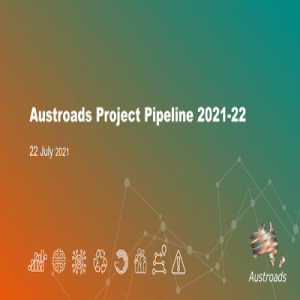
Thursday Jul 22, 2021
Austroads Project Pipeline 2021-22
Thursday Jul 22, 2021
Thursday Jul 22, 2021
This webinar provides an overview of Austroads’ projects 2021-22 and what is required to work with Austroads.
The session is beneficial to consultants who may be interested in tendering for Austroads projects.
The projects discussed focus on data collection and management, digital engineering, tunnel design and componentry, bridge assessment, pavement technology, road design, road safety audits, driver licensing, environment reporting, and vehicle and infrastructure connectivity.
The webinar is presented by Paul Davies, Austroads Acting General Manager Operations, and program managers:
- Ross Guppy, Program Manager Transport Infrastructure
- Michael Nieuwesteeg, Program Manager Road Safety and Design
- Richard Delplace, Program Manager Transport Network Operations
- Vibeke Matthews, Acting Program Manager Future Vehicles and Technology, and Environment and Sustainability Program.
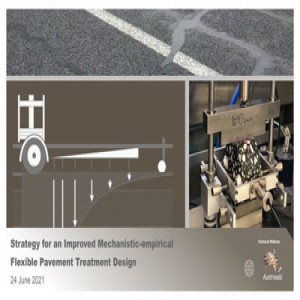
Thursday Jun 24, 2021
Strategy for an Improved Mechanistic-empirical Flexible Pavement Treatment Design
Thursday Jun 24, 2021
Thursday Jun 24, 2021
Following the update of the Austroads Guide to Pavement Technology Part 5: Pavement Evaluation and Treatment Design in 2019, Austroads commissioned the development of a strategy for future improvement of the mechanistic-empirical procedure (MEP) used in pavement rehabilitation and strengthening treatment design.
This webinar, presented by Dr Didier Bodin and Dr Geoff Jameson, outlines future research direction derived from the review of national and international literature and road agency best practice. Priority areas were identified through engagement with pavement designers across road agencies and industry. The main topics presented include:
- Methods to characterise past and future fatigue damage of existing bound pavement layers.
- Design method to quantify the extent of reflective cracking in treatment layers.
- Enhanced use of traffic speed deflectometer data.
The roadmap for short, medium and long-term strategy will inform future research program towards providing pavement designers with improved pavement rehabilitation design procedures in the near future.
The webinar also discusses practical aspects of the pavement and subgrade layers moduli back-calculation from measured surface deflections.
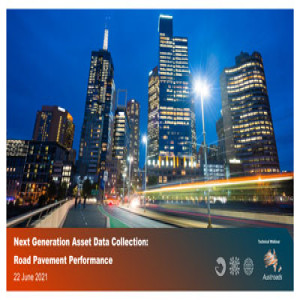
Tuesday Jun 22, 2021
Next Generation Asset Data Collection: Road Pavement Performance
Tuesday Jun 22, 2021
Tuesday Jun 22, 2021
The increasing pace of change of technology brings considerable promise of more data, of a higher quality, captured for a lower cost. This has the potential to improve the asset management of roads by enabling better decision making and providing a more complete picture of asset performance.
These benefits, however, are not automatic. For asset managers, it can be difficult to know what technology is available and how the benefits compare to costs. There is also often considerable friction in moving to new approaches as existing processes and systems are tailored for the status quo. Perhaps the biggest hurdle is confidence in moving from an existing approach to having trust in the unknown.
In response to this need to understand the emerging technologies available, the cost-effectiveness of these technologies, and the implications of transitioning from existing to new approaches, Austroads has developed a research report on next generation data collection technologies for road pavement assets.
With specific reference to road pavement assets, this webinar takes attendees through:
- The key themes across the data required to inform asset management decisions.
- The current state of data collection technologies.
- The interconnected ecosystem of emerging data collection technologies.
- A structured framework for evaluating the cost-effectiveness of emerging data collection technologies.
- Insights from the application of the evaluation framework and implications for future approaches to data collection.
Presented by David Jansen, Susan Chamberlain, Ella Hingston, Dr Colin Kemp and Trevor Chiang.
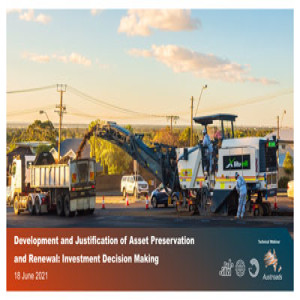
Friday Jun 18, 2021
Friday Jun 18, 2021
This is a final session in the series of three webinars based on the Austroads report Prolonging the Life of Road Assets Under Increasing Demand: A Framework and Tools for Informing the Development and Justification of Asset Preservation and Renewal.
It is presented by Tim Martin, Tyrone Toole and Qindong Li, and explains the broad framework and the economic and customer centred basis for justifying appropriate levels of investment in road asset preservation and renewal. Examples include those which impact strategic, network level decisions and supporting policies and processes.
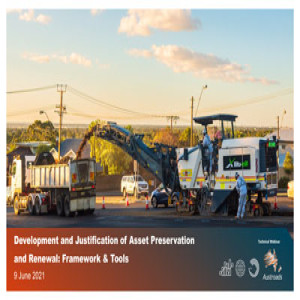
Wednesday Jun 09, 2021
Development and Justification of Asset Preservation and Renewal: Framework and Tools
Wednesday Jun 09, 2021
Wednesday Jun 09, 2021
This is the second session in a series to present the findings of Prolonging the Life of Road Assets Under Increasing Demand: A Framework and Tools for Informing the Development and Justification of Asset Preservation and Renewal.
The webinar, presented by Tyrone Toole, Dr Tim Martin, Ranita Sen, Qindong Li and Liam Terris, explains the framework, tools and case studies in detail, and how asset management practitioners can apply these in their day-to-day work.
The emphasis is on reinforcing good practice and its justification and how different preservation and renewal options can be evaluated.
It also provides a detailed introduction into the Pavement Life-cycle Costing tool, followed by worked examples through the presentation of several case studies.
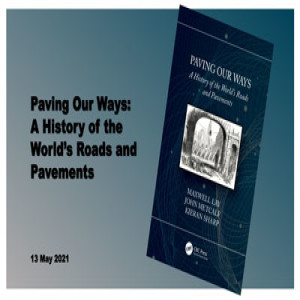
Thursday May 13, 2021
Paving our ways
Thursday May 13, 2021
Thursday May 13, 2021
This webinar presents a book “Paving Our Ways”, which references Austroads’ research and provides a comprehensive international history of the world’s pavements, running from the earliest human settlements to the present day. No previous book has covered such a broad canvass.
The book is written for general and technically oriented readers, tracing the human and social aspects of pavement development and use and providing detailed technical background. It also caters to students of engineering and transport wishing to broaden their knowledge of their profession or taking a course in the history and sociology of engineering.
“Paving Our Ways” provides interesting and curious asides about the stranger aspects of pavements. It explores the controversies surrounding the development of macadam pavements and, later, of asphalt pavements in a way that provides many insights into modern pavements. It also examines the subsequent competition between pavements using bituminous or cementitious binders.
The book covers three major time zones. The first is from the times of the Egyptian pharaohs to the end of the Roman era, the second is from the Middle Ages to the beginning of the First World War during which people like Tresaguet, Telford and McAdam had major impacts, and the third is from the end of the First World War to the present time when motorised trucks and machinery dramatically changed the way the pavements were made and used.
Looking back on the way current pavement technologies evolved, the authors of the book Maxwell Lay, formerly Director ConnectEast and Australian Road Research Board, John Metcalf, Formerly Louisiana State University, USA and Kieran Sharp, Road Eng. Assoc. of Asia and Australasia show how Australian practice relates to international practice.
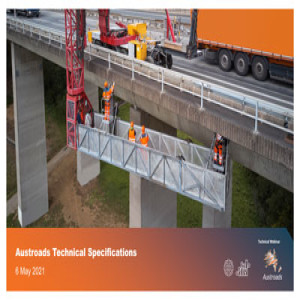
Thursday May 06, 2021
Austroads Technical Specifications for Roadworks and Bridgeworks
Thursday May 06, 2021
Thursday May 06, 2021
Currently, most Austroads member agencies rely on their unique technical specifications for the delivery of roadworks and bridge projects. In many cases, these specifications have been developed over a number of years in consultation with local industry and suppliers.
While it is recognised that there will always be some requirements that will only apply to a single jurisdiction, standardising specifications (and the associated test methods) has the potential to improve work processes for road agencies, suppliers and contractors.
To increase efficiency for road agencies and industry and optimise compliance with contract requirements, 14 technical specifications have been published for all Austroads member agencies to use for the construction of roadworks and bridgeworks. These specifications are suitable for use with any general conditions of contract, including design and construct contracts. They are expected to be used in conjunction with supplementary local or contract specific requirements.
This webinar, presented by Richard Edwards, takes participants through the technical specifications development process and provides an overview of the structure and layout adopted for the specifications.

Wednesday Dec 16, 2020
Wednesday Dec 16, 2020
The addition of a small amount of cementitious binder to non-standard granular materials may result in a fit for purpose base or subbase at a significantly lower cost than crushed rock complying with standard specifications. Such lightly bound cemented (LBC) materials have particular use in pavement rehabilitation and heavy patching as they are less susceptible to block cracking and crocodile cracking than cemented materials.
The binder content and strength of LBC materials are significantly lower than heavily bound cemented (HBC) materials. Austroads’ recent report, which reviewed the performance of selected Queensland pavements with LBC bases, has shown that it is possible to design and construct a low-strength material with base thickness and subbase support sufficient to limit the extent of the micro cracking development that leads to macro-cracking.
Considering the use and performance of LBC for moderate to heavily trafficked roads, a structural design method was developed for pavements containing LBC materials and HBC materials in the post fatigue cracking phase of life, including:
- A new elastic characterisation method, applicable to LBC materials and HBC materials in the fatigue cracked state, including methods to vary the design modulus according to the design modulus of the layer supporting the cracked material and the thickness and modulus of the overlying bound materials.
- Design charts to select LBC base thicknesses to inhibit the development of block cracking and crocodile cracking, with the minimum thickness varying with design traffic loading and the support provided by the layer under the LBC base.
This webinar, presented by Dr Geoff Jameson and Dr James Grenfell, explains the structural design method in detail, including its development and application.

Wednesday Oct 21, 2020
Implications of Pavement Markings for Machine Vision
Wednesday Oct 21, 2020
Wednesday Oct 21, 2020
Introducing automated vehicles could dramatically impact the Australian and New Zealand travelling public’s driving experience and the industry’s approach to road safety and road design. This journey will undoubtedly take many years and considerable efforts in partnerships, testing, certification, design and legislation. A growing range of vehicles already available in the market offer automated-steering functions enabled by Advanced Driver-Assistance Systems (ADAS). Their performance depends on the vehicle’s technology and the environment where they are used. Greater consistency and quality in pavement markings will benefit not only automated vehicles but also all road users.
This webinar, presented on 21 October 2020 by Julien Marr, April Zhang, Scott Benjamin and John Wall, focuses on the outcomes of the Austroads research project, which was conducted to understand how longitudinal pavement markings affect automated steering functions and how existing design and maintenance practices could be improved.

